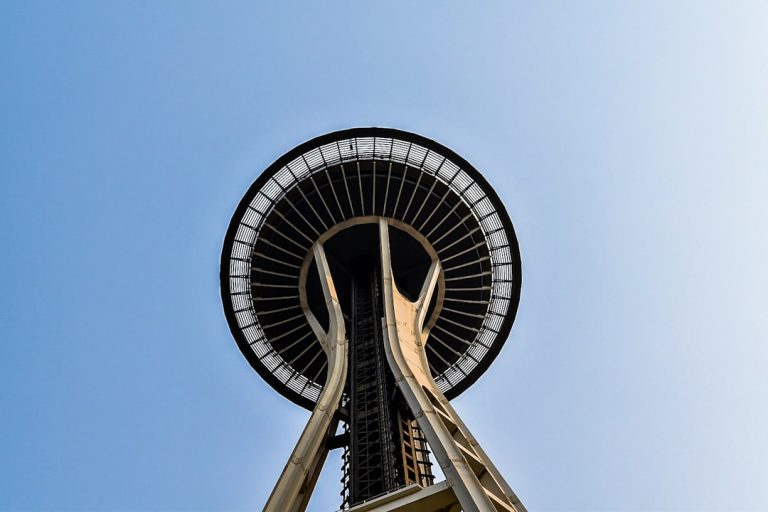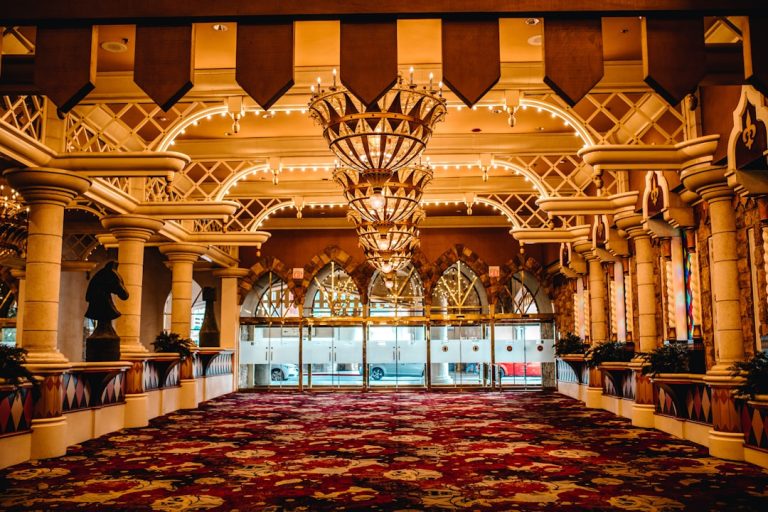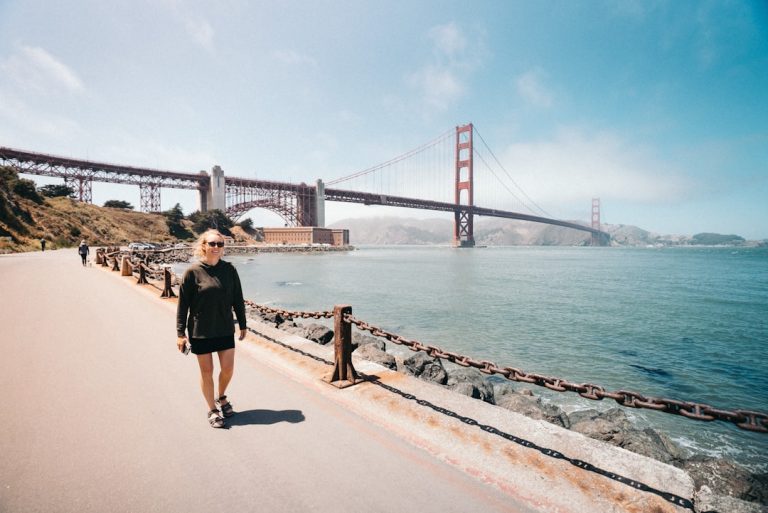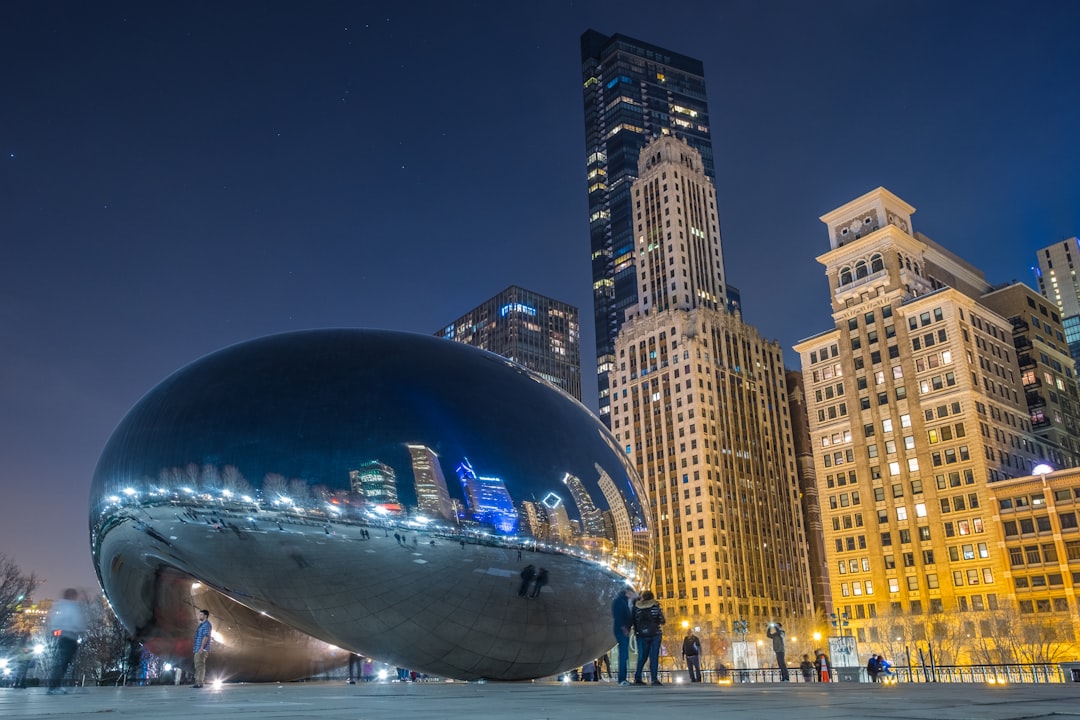
Chicago’s history is a rich tapestry woven from the threads of indigenous cultures, European exploration, and rapid urban development. The area now known as Chicago was originally inhabited by Native American tribes, including the Potawatomi, who thrived on the land’s natural resources. The name “Chicago” is derived from a Native American word, “shikaakwa,” which refers to the wild leeks that grew abundantly in the region.
In 1673, French explorers Jacques Marquette and Louis Jolliet were among the first Europeans to traverse the area, recognizing its strategic importance as a trade route between the Great Lakes and the Mississippi River. The establishment of Fort Dearborn in 1803 marked a significant turning point in Chicago’s history. This military outpost attracted settlers and traders, leading to the town’s incorporation in 1833.
The arrival of the railroads in the mid-19th century catalyzed Chicago’s growth, transforming it into a bustling hub for commerce and industry. The Great Chicago Fire of 1871 was a pivotal event that devastated much of the city but also provided an opportunity for reconstruction and innovation. Architects like Daniel Burnham and Louis Sullivan emerged during this period, leading to the development of the Chicago School of architecture, characterized by its use of steel-frame construction and large plate glass windows.
As the 20th century unfolded, Chicago continued to evolve, becoming a center for culture, politics, and social movements.
The post-World War II era saw an influx of immigrants from various parts of the world, further enriching Chicago’s cultural landscape.
Today, Chicago stands as the third-largest city in the United States, known for its diverse population, vibrant arts scene, and significant contributions to American history.
Key Takeaways
- Chicago has a rich history dating back to the 19th century, and has evolved into a modern metropolis known for its architecture and cultural significance.
- Must-see attractions in Chicago include the iconic skyline, famous museums such as the Art Institute of Chicago, and the Navy Pier.
- Chicago’s diverse neighborhoods offer unique experiences, from the vibrant culture of Pilsen to the upscale shops of the Magnificent Mile.
- The culinary scene in Chicago is diverse, featuring deep-dish pizza, Michelin-starred restaurants, and a wide range of international cuisines.
- Outdoor activities in Chicago abound, with beautiful Lake Michigan, scenic parks, and gardens providing ample opportunities for recreation and relaxation.
- Navigating Chicago is made easy with public transportation options and the best times to visit popular attractions are during the spring and fall seasons.
Must-see attractions in Chicago: From the iconic skyline to the famous museums
Chicago’s skyline is one of the most recognizable in the world, dominated by architectural marvels such as the Willis Tower (formerly known as the Sears Tower) and the John Hancock Center. The Willis Tower, once the tallest building in the world, offers breathtaking views from its Skydeck, where visitors can step onto “The Ledge,” a glass balcony extending four feet outside the building. This thrilling experience provides a unique perspective of the city below and is a must for any visitor seeking an adrenaline rush.
The Art Institute of Chicago is home to an extensive collection of Impressionist and Post-Impressionist masterpieces, including works by Monet, Van Gogh, and Seurat. The museum’s iconic bronze lion statues at its entrance are a symbol of its cultural significance.
For those interested in science and history, the Field Museum offers fascinating exhibits on natural history, including Sue, the largest and most complete Tyrannosaurus rex skeleton ever discovered. The Museum of Science and Industry further captivates visitors with interactive displays that explore innovation and technology. Beyond these highlights, Millennium Park serves as a cultural hub in downtown Chicago.
The park features the famous Cloud Gate sculpture, affectionately known as “The Bean,” which reflects the city’s skyline and draws countless visitors for photo opportunities. Additionally, the Jay Pritzker Pavilion hosts free concerts during the summer months, showcasing local talent and providing a vibrant atmosphere for relaxation and enjoyment.
Exploring Chicago’s diverse neighborhoods: From the vibrant culture of Pilsen to the upscale shops of the Magnificent Mile
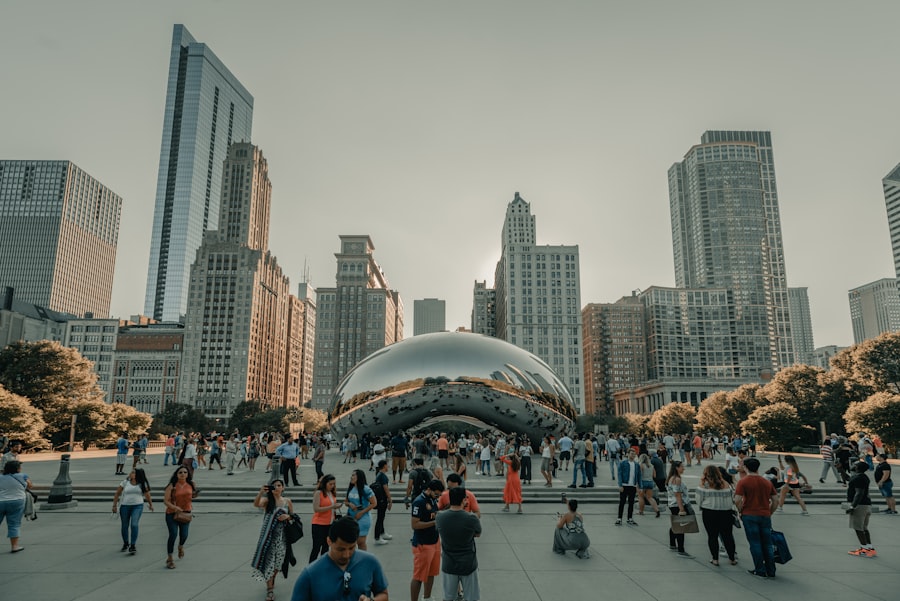
Chicago is a city defined by its neighborhoods, each offering a unique blend of culture, history, and community spirit. Pilsen, located on the Lower West Side, is renowned for its vibrant Mexican-American culture. The neighborhood is adorned with colorful murals that tell stories of heritage and identity.
Visitors can explore local galleries such as the National Museum of Mexican Art, which showcases traditional and contemporary Mexican art. Pilsen also boasts an array of authentic taquerias and bakeries where one can savor traditional dishes like tamales and pan dulce. In stark contrast to Pilsen’s artistic vibrancy is the Magnificent Mile, a bustling stretch along Michigan Avenue known for its upscale shopping and dining experiences.
This iconic avenue features flagship stores from luxury brands such as Gucci and Louis Vuitton alongside renowned department stores like Neiman Marcus. The Magnificent Mile is not just about shopping; it also offers a plethora of dining options ranging from casual eateries to fine dining establishments. Visitors can indulge in culinary delights while enjoying views of Lake Michigan and historic architecture.
Another notable neighborhood is Wicker Park, celebrated for its eclectic mix of boutiques, music venues, and trendy restaurants. This area has become a hotspot for young professionals and artists alike. The neighborhood’s vibrant nightlife scene includes live music at venues like The Empty Bottle and intimate performances at smaller bars.
Wicker Park also hosts various festivals throughout the year, celebrating everything from food to art.
The culinary scene in Chicago: From deep-dish pizza to Michelin-starred restaurants
| Culinary Scene in Chicago | Statistics |
|---|---|
| Number of Michelin-starred restaurants | 25 |
| Number of James Beard Award-winning chefs | Over 40 |
| Percentage of restaurants serving deep-dish pizza | Approximately 70% |
| Annual food festivals | Over 20 |
| Number of diverse culinary neighborhoods | Over 77 |
Chicago’s culinary landscape is as diverse as its population, offering an array of flavors that reflect both tradition and innovation. One cannot discuss Chicago cuisine without mentioning deep-dish pizza—a dish that has become synonymous with the city itself. This hearty pizza features a thick crust that forms a deep dish filled with layers of cheese, toppings, and chunky tomato sauce.
Iconic establishments like Giordano’s and Lou Malnati’s have become pilgrimage sites for pizza lovers seeking to experience this quintessential Chicago dish. Beyond deep-dish pizza, Chicago is home to a thriving fine dining scene that has garnered international acclaim. The city boasts several Michelin-starred restaurants that showcase culinary excellence and creativity.
Alinea, led by chef Grant Achatz, is often regarded as one of the best restaurants in the world. Known for its avant-garde approach to cuisine, Alinea offers a multi-sensory dining experience that challenges traditional notions of food presentation and flavor combinations. Another standout is Oriole, which combines seasonal ingredients with global influences to create exquisite tasting menus that change regularly.
The restaurant’s intimate setting enhances the dining experience, allowing guests to savor each dish while engaging with knowledgeable staff who share insights about the culinary journey. Chicago’s food scene also embraces diverse ethnic cuisines reflecting its multicultural heritage. Neighborhoods like Chinatown offer authentic dim sum experiences at places like MingHin Cuisine, while Little Italy serves up classic Italian fare at family-owned trattorias.
Food festivals throughout the year celebrate this diversity, allowing locals and visitors alike to sample dishes from various cultures.
Outdoor activities in Chicago: From the beautiful Lake Michigan to the scenic parks and gardens
Chicago’s location along Lake Michigan provides ample opportunities for outdoor activities that cater to both relaxation and adventure seekers. The lakefront features an extensive network of parks and beaches that invite residents and visitors to enjoy nature within an urban setting. One popular destination is North Avenue Beach, where sunbathers flock during warm summer months to soak up the sun or partake in beach volleyball games.
The 18-mile-long Lakefront Trail runs parallel to Lake Michigan, offering stunning views of both the water and the city skyline. This paved path is perfect for walking, jogging, or cycling while enjoying fresh breezes off the lake. Along this trail are several parks such as Lincoln Park and Grant Park—each providing green spaces for picnics or leisurely strolls amidst beautiful gardens.
For those seeking more structured outdoor activities, Chicago offers numerous recreational facilities including golf courses, tennis courts, and sports fields scattered throughout its parks. The city’s commitment to green spaces is evident in initiatives like “Chicago Plays,” which aims to enhance play areas for children across neighborhoods. In addition to parks and beaches, Chicago is home to several botanical gardens that showcase stunning flora year-round.
The Chicago Botanic Garden in Glencoe features 27 gardens spread across 385 acres—an oasis that attracts nature enthusiasts looking to escape urban life without venturing far from downtown.
Tips for navigating Chicago: From public transportation to the best times to visit popular attractions
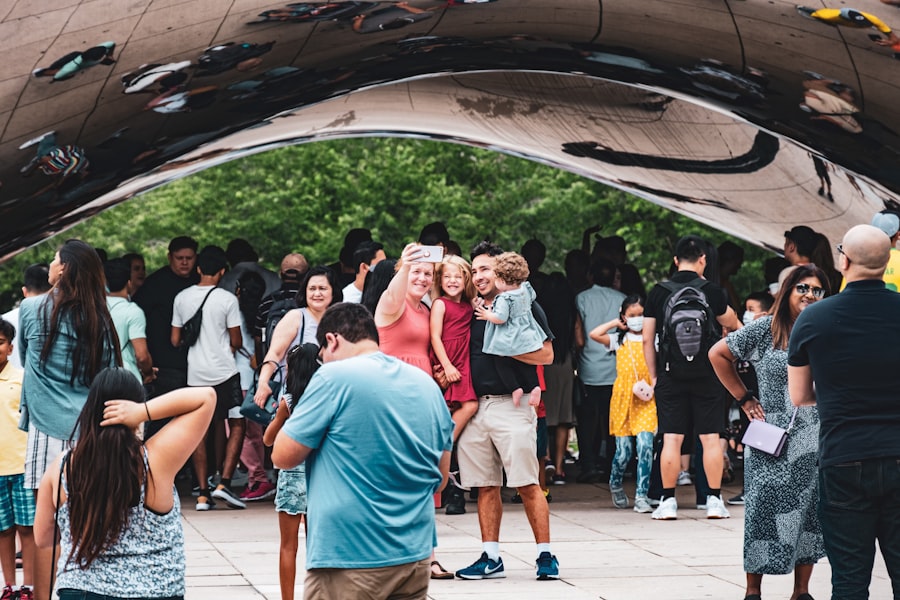
Navigating Chicago can be an enjoyable experience thanks to its well-developed public transportation system comprising buses and trains operated by the Chicago Transit Authority (CTA). The “L” train system is particularly convenient for tourists as it connects major attractions throughout downtown and surrounding neighborhoods. Purchasing a Ventra card allows for easy access to both trains and buses while providing discounted fares for multiple rides.
For those who prefer exploring on foot or by bike, many neighborhoods are pedestrian-friendly with designated bike lanes available throughout the city. Divvy bike-sharing stations are conveniently located across Chicago—offering an affordable way to explore at your own pace while enjoying scenic routes along Lake Michigan or through vibrant neighborhoods. Timing your visit can significantly enhance your experience when exploring popular attractions like Millennium Park or Navy Pier.
Weekdays tend to be less crowded than weekends; however, summer months attract tourists eager to enjoy outdoor events and festivals held throughout the city. Planning visits during off-peak hours—early mornings or late afternoons—can also help avoid long lines at museums or restaurants. Lastly, consider checking local event calendars before your trip; Chicago hosts numerous festivals celebrating everything from food to music throughout the year.
Participating in these events not only enriches your experience but also provides insight into local culture while connecting you with residents who share their love for this vibrant city.
If you’re intrigued by the diverse attractions and historical insights provided in the article about Chicago, Illinois, you might also enjoy exploring different global destinations and their unique offerings. For instance, you can learn about the enchanting landscapes and rich history of Burma by visiting Burma: Facts and Places to Visit. This article provides a fascinating glimpse into another culturally rich destination, offering insights that can enhance your appreciation for global diversity and history.
FAQs
What are some interesting facts about Chicago, Illinois?
– Chicago is the third most populous city in the United States.
– It is home to the first skyscraper in the world, the Home Insurance Building, built in 1885.
– The city is known for its deep-dish pizza and Chicago-style hot dogs.
– Chicago is the birthplace of the modern skyscraper and is known for its impressive architecture.
What are some popular places to visit in Chicago, Illinois?
– Millennium Park, home to the famous Cloud Gate sculpture, also known as “The Bean.”
– The Art Institute of Chicago, one of the oldest and largest art museums in the United States.
– Navy Pier, a popular tourist attraction with shops, restaurants, and entertainment options.
– The Willis Tower Skydeck, offering breathtaking views of the city from the 103rd floor.
What are some must-see things in Chicago, Illinois?
– The iconic Chicago skyline, best viewed from the shores of Lake Michigan.
– The Chicago Riverwalk, offering scenic views and a vibrant atmosphere.
– The Magnificent Mile, a prestigious section of Michigan Avenue known for its shopping and dining options.
– The historic Wrigley Field, home of the Chicago Cubs baseball team.
